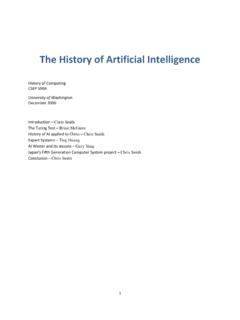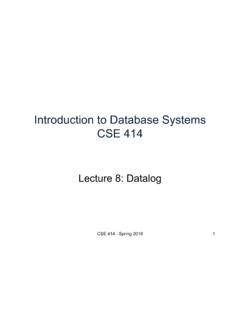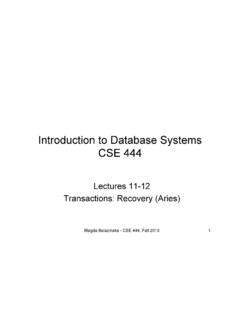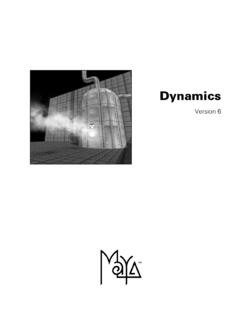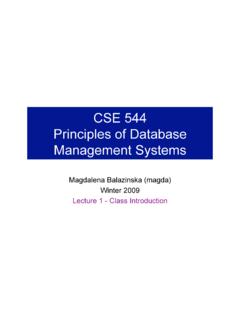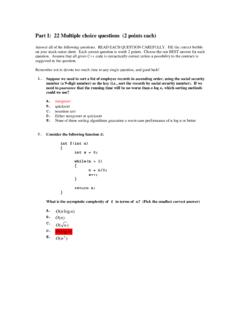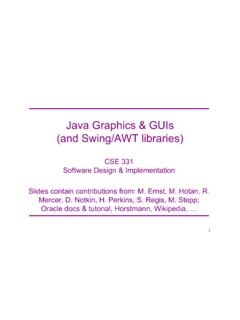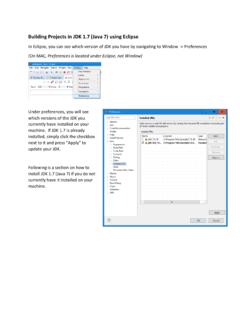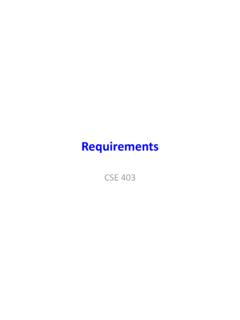Transcription of Solving Problems with Turing Machines
1 1R. Rao, CSE 322)We know L = {0n1n0n| n 0} is not a CFL (pumping lemma))Can we show L is decidable? Construct a decider M such that L(M) = L A decideris a TM that always halts (in qaccor qrej) and is guaranteed not to go into an infinite loop for any inputSolving Problems with Turing : Mark off matching 0s, 1s, and 0s with Xs(left end marked with blank)Input: 0000011111000002R. Rao, CSE 322 Idea for a Decider for {0n1n0n| n 0} )General Idea: Match each 0 with a 1 and a 0 following the 1.)Implementation Level Descriptionof a Decider for L: On input w:1. If first symbol = blank, ACCEPT2. If first symbol = 1, REJECT3. If first symbol = 0, Write a blank to mark left end of current symbol is 0 or X, skip until it is 1. REJECT if X over 1. Skip 1 s/X s until you see 0. REJECT if X over 0. Move back to left end of At left end: Skip X s see 0: Write X over 0 and GOTO see 1: see a blank space: ACCEPT3R.
2 Rao, CSE 322 State Diagram)Try running the decider on: 010, 001100, .. ACCEPT 0, 000, 0100, .. REJECTq0qskip0qskip1qgo-leftqat-leftqACC qREJ0 _,R1 X,R0 X,L_ R0 X,R_ R_ R1 RX R0 RX R1 RX L0 L1 LX R What about 010010?1 RqREJNote: Some transitions to qREJ( , from qskip0) are not shown to avoid clutter4R. Rao, CSE 322 Houston, we have a our Turing Rao, CSE 322 What s the problem?)The decider accepts incorrect strings: 010010, 010001100 ACCEPT!!! Accepts (0n1n0n)*Need to fix _,R1 X,R0 X,L_ R0 X,R_ R_ R1 RX R0 RX R1 RX L0 L1 LX R1 RqREJ6R. Rao, CSE 322)Scan initially to make sure string is of the form 0*1*0*)On input w:1. If first symbol = blank, ACCEPT2. If first symbol = 1, REJECT3. If first symbol = 0: if w is not in 00*11*00*, REJECT; else,Write a blank to mark left end of current symbol is 0 or X, skip until it is 1. REJECT if X over 1. Skip 1 s/X s until you see 0.
3 REJECT if X over 0. Move back to left end of At left end: Skip X s see 0: Write X over 0 and GOTO see 1: see a blank space: ACCEPTA Simple Fix (to the Decider) Add this7R. Rao, CSE 322 The Decider TM for L in all its gloryq0qskip0qskip1qgo-leftqat-leftqACCq REJ0 _,R1 X,R0 X,L_ R0 X,R_ R_ R1 RX R0 RX R1 RX L0 L1 LX Rq11 Rq20 Rq30 R1 R0 R_ L1 RqREJqREWNew part testsfor 00*11*00*0 L1 L_ R1 RqREJ8R. Rao, CSE 322 Can we augment the power of Turing Machines with various accessories?9R. Rao, CSE 322 Varieties of TMsWhat if we allow nondeterminism?What if we allow multiple tapes?What if my date doesn t show up tonight?10R. Rao, CSE 322 Various Types of TMs)Multi-Tape TMs: TM with k tapes and k heads : Q k Q k {L,R}k (qi, a1, .., ak) = (qj, b1, .., bk, L, R, .., L) )Nondeterministic TMs (NTMs) : Q Pow(Q {L,R}) (qi, a) = {(q1, b, R), (q2, c, L), .., (qm, d, R)})Enumerator TM for L: Prints all strings in L (in any order, possibly with repetitions) and only the strings in L)Other types: TM with Two-way infinite tape, TM with multiple heads on a single tape, 2D infinite tape TM, Random Access Memory (RAM) TM, Rao, CSE 322 Surprise!
4 All TMs are born )Each of the preceding TMs is equivalent to the standard TM They recognize the same set of languages (the Turing -recognizable languages))Proof idea: Simulate the deviant TM using a standard TM)Example 1: Multi-tape TM on a standard TM Represent k tapes sequentially on 1 tape using separators # Use new symbol ato denote a head currently on symbol a0 1 ..b a h ..3 2 2 .. # 0 1# b ah # 32 2 # ..(See text for details)12R. Rao, CSE 322 Example 2: Simulating Nondeterminism)Any nondeterministic TM N can be simulated by a deterministic TM M NTMs: : Q Pow(Q {L,R}) No transitions but can simulate them by reading and writing same symbol N accepts w iff there is at least 1 path in N s tree for w ending in qACC)General proof idea: Simulate each branch sequentially Proof idea 1: Use depth first search?No, might go deep into an infinite branch and never explore other branches!
5 Proof idea 2: Use breadth first searchExplore all branches at depth nbefore n+1q0(q1, b, R)(q2, c, L)qREJqACCThis branch doesnot haltabaa13R. Rao, CSE 322 Simulating Nondeterminism: Details, Details)Use a 3-tape DTM M for breadth-first traversal of N s tree on w: Tape 1 keeps the input string w Tape 2 stores N s tape during simulation along 1 path (given by tape 3) up to a particular depth, starting with w Tape 3 stores current path = root node q0213 = path made up of 3rdchild of 1stchild of 2ndchild of root)See text for more detailsq0(q1, b, R)(q2, c, L)qREJqACCD oesnot halt213aa14R. Rao, CSE 322 What about other types of computing Machines ?)Enumerator TMs (or Printer Machines ))TMs with 2-Way Infinite Tape)TMs with Multiple Read/Write Heads)TMs with 2-Dimensional Tape)TMs with Random Access Memory (RAM)15R. Rao, CSE 322 The Church- Turing Thesis)Various definitions of algorithms were shown to be equivalent in the 1930s)Church- Turing Thesis: The intuitive notion of algorithms equals Turing machine algorithms Turing Machines serve as a precise formal model for the intuitive notion of an algorithm) Any computation on a digital computer is equivalent to computation in a Turing machine Dude, that s pretty Rao, CSE 322 Recap: Recognizable versus Decidable Languages)A language L is called Turing -Recognizableif there exists a TM M such that L(M) = L Note: M need not halt on all inputs but it should halt and accept all and only those strings that are in L; it can reject strings by either going to qrejor by looping forever)A TM is a deciderif it halts on all inputs)A language L is decidableif there exists a deciderD such that L(D) = L17R.
6 Rao, CSE 322 Closure Properties of Decidable Languages)Decidable languages are closed under , , *, , and complement)Example: Closure under )Need to show that union of 2 decidable L s is also decidableLet M1 be a decider for L1 and M2 a decider for L2A decider M for L1 L2:On input w:1. Simulate M1 on w. If M1 accepts, then ACCEPT w. Otherwise, go to step 2 (because M1 has halted and rejected w)2. Simulate M2 on w. If M2 accepts, ACCEPT w else REJECT accepts w iff M1 accepts w OR M2 accepts L(M) = L1 L218R. Rao, CSE 322 Closure Properties)Consider the proof for closure under A decider M for L1 L2:On input w:1. Simulate M1 on w. If M1 accepts, then ACCEPT w. Otherwise, go to step 2 (because M1 has halted and rejected w)2. Simulate M2 on w. If M2 accepts, ACCEPT w else REJECT accepts w iff M1 accepts w OR M2 accepts L(M) = L1 L2 Will the same proof work for showing Turing -recognizable languagesare closed under ?
7 Why/Why not? , will M1 always halt?!M1 may never halt but w may be in L219R. Rao, CSE 322 Closure Properties of Recognizable Languages) Turing recognizable languages are closed under A TM M for L1 L2:On input w:Simulate M1 and M2 alternativelyon w step by step . If either accepts, then ACCEPT w. If both halt and reject w, then REJECT (M) = L1 L2 If either M1 or M2 accepts, then M accepts w (even if one of them loops, M will accept and halt when the other accepts and halts because M alternates between M1 and M2). Otherwise, M rejects w by halting or by looping Rao, CSE 322 Closure for Recognizable Languages) Turing -Recognizable languages are closed under , , *, and (but not complement! We will see this later))Example: Closure under Let M1 be a TM for L1 and M2 a TM for L2 (both may loop)A TM M for L1 L2:On input w:1. Simulate M1 on w. If M1 halts and accepts w, go to step 2.
8 IfM1 halts and rejects w, then REJECT w. (If M1 loops, then M will also loop and thus reject w) 2. Simulate M2 on w. If M2 halts and accepts, ACCEPT w. If M2 halts and rejects, then REJECT w. (If M2 loops, then M will also loop and thus reject w) M accepts w iff M1 accepts w AND M2 accepts w L(M) = L1 L2

